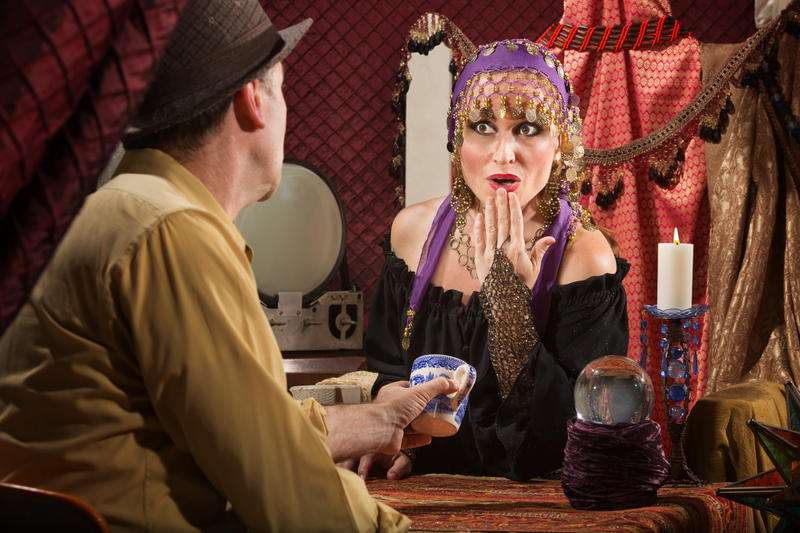When you think of reading tea leaves, you most likely see visions of Professor Trelawney hovering over Harry’s cup in Divination class, spouting off vague premonitions of The Grim.
However, the art of reading tea leaves dates back centuries and is steeped in history and tradition.
What is Tasseography?
Tasseography is the traditional term for the art of reading tea leaves.
Tea leaf reading is an old way of predicting the future and obtaining precise answers by analyzing the patterns of tea leaves in a cup.
Reading dates back many millennia to Ancient China. It is thought to have started shortly after the Chinese Emperor Shen Nun discovered tea in 2737 BC. Before this, Chinese monks practiced a similar skill by inspecting the fractures inside a bell.
Tasseomancy was used by both Baltic and Slavic cultures and followed the trading routes of tea and coffee.
It is also connected to the Romani people, whose nomadic lifestyle helped spread the practice.
Different countries have performed it with minor changes throughout history, indicating that this divination was an oral tradition.
Although it is not regarded as a closed cultural practice, it is customary to seek permission from a Romani elder as a gesture of respect.
Western tasseography may be traced back to medieval European Fortune-tellers, who got their readings from splatters of wax, lead, and other liquid substances.
How to read tea leaves as a beginner
The Tools
You can read tea leaves from any cup as long as it is rounded with a handle. Don’t forget to include some saucers. It doesn’t need to match your cup. It’s just there to catch the drips when you turn the cup upside down.
The type of teapot you use doesn’t matter either as long as it does not contain a filter of any kind.
When it comes to the type of tea, you need to choose loose leaf tea. Green tea, black tea, white tea, or oolong tea are the most popular for tea leaf reading.
The Steps
Reading tea leaves is simple once you get the hang of it.
Tea leaf reading, like many divination methods, is founded on the notion of channeling energy. When we focus our purpose on the tea, the leaves transform into energy conduits capable of reflecting our experiences — even those that have yet to occur. When prodded, the leaves expose hidden obstructions, provide advice, and even predict the future—these mysterious messages embedded in the form, density, color, and positioning of the moist leaves.
For a beginner, it is recommended that you practice yourself first until you feel confident in what you see and predict.
Step 1: Before you start, let your mind empty of all other thoughts besides the act of divination.
Step 2: Once the tea is prepared, let it steep for a few minutes.
Step 3: Drink the tea but leave about a teaspoon of it at the bottom of the cup.
Step 4: Grab hold of the handle and focus your mind on what you are hoping to divine from the tea leaves.
Step 5: Swirl the cup in a counterclockwise direction.
Step 6: Take the cup and invert it over the saucer until the liquid is gone leaving only tea leaves behind.
Step 7: Slowly turn the cup’s right side up.
Step 8: Look at the tea leaves. As you focus on the leaves, remember to keep calm and centered. Discerning shapes from tea leaves can be complex at first, but it gets easier with practice. Trust your first impressions, and don’t rush the process. Don’t try to force anything. Let the premonition come to you naturally.
Step 9: Look at the different sections of the cup for different timeframes.
- The rim represents the present
- The sides define the medium term.
- The bottom represents the distant future.
Step 10: Start the reading by looking at the most prominent symbols and work your way down in size.
Step 11: Read the tea leaves in a manner that reveals a cohesive reading.
Step 12: Keep a diary of the symbols and reading you come up with. Be as detailed as possible. This will help to strengthen your knowledge and build your confidence in your reading.
What are the different symbols and meanings?
The different symbols and their meaning:
- Aircraft: projects that failed
- Anchor: thriving in business and a steady romantic relation
- Angel: uplifting news, particularly in love-related matters
- Apples: long life; accomplishment in school or business
- Arrows: unfortunate messages or news from the direction in which the arrow points
- Ax: beating issues
- Birds: best of luck, possibly a good journey
- Boat: a friend visiting
- Bouquet represents good circumstances, including your friends, love life, and financial issues.
- Bridge: a journey that is positive
- Butterfly: pleasure and success
- Candle: enlightenment
- Car: wealth
- Castle: unexpected fortune
- Circles: expect presents or money
- Clouds: troubles
- Clover: excellent luck; prosperity and happiness
- Coffin: extensive sickness or the death of a loved one
- Compasses: business travel
- Cow: success
- Cross: trouble, death, or delay
- Crown: honor and success
- Dagger: friends helping
- Dragon: large and abrupt changes
- Eagle: riches and honor achieved through a change in housing
- Elephant: good health and luck
- Fish: great news from another country
- Fox: backstabbing from a very good friend
- Goat: adversaries
- Greyhound: good fortune through hard work
- Gun: slander, disharmony
- Hammer: overcoming challenges
- Hat: success in your life
- Heart: good things to come, such as marriage and money
- Horseshoe: a lucky trip, success in choosing a partner
- Hourglass: imminent risk
- House: success in business
- Kettle: death
- Kite: a long trip leading to pride and esteem
- Knife: disaster met through hatred and fighting
- Ladder: travel
- Letter: news
- Lines: journey
- Moon: success and happiness; a crescent moon would mean prosperity
- Mountain: a powerful friend or, if many mountains, powerful adversaries
- Mushroom: sudden separation of lovers following a fight
- Owl: poverty, sickness, warnings against starting a new business, deceitfulness in love, and other unlucky events
- Pear: social status, wealth, a financially beneficial business moves or marriage
- People: varies with what they are doing, but the symbol of people is usually good
- Pig: jealous friends but a faithful lover
- Pine tree: satisfaction
- Rabbit: success in a city
- Rat: losses through employees or enemies
- Reptiles: arguments
- Ring: marriage
- Saw: troubled strangers
- Scales: lawsuit
- Scissors: a breakup, illness, or arguments
- Shark: risk of death
- Sheep: success and prosperity
- Ship: great journey
- Snakes: a bad omen; be careful
- Squares: peace and comfort
- Star: very good luck
- Swan: happy love life and great luck
- Sword: arguments, especially with lovers; a broken sword would mean an enemy will win
- Trees: good luck
- Triangles: unexpected inheritance and good fortune
- Umbrella: annoyance and difficulty
- Unicorn: scandal
- Wheel: inheritance
- Worms: secret enemies




No Comments